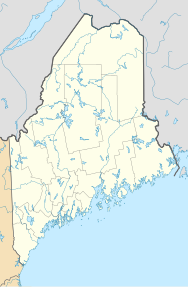Arrowsic, Maine
| Arrowsic, Maine | |
|---|---|
| Town | |

Doubling Point Light c. 1907
|
|
| Nickname(s): The Pine Tree State | |
| Motto: Dirigo (I lead) | |
| Location within the state of Maine | |
| Coordinates: 43°52′19″N 69°47′10″W / 43.87194°N 69.78611°W | |
| Country | United States |
| State | Maine |
| County | Sagadahoc |
| Incorporated | 1841 |
| Area | |
| • Total | 10.79 sq mi (27.95 km2) |
| • Land | 7.75 sq mi (20.07 km2) |
| • Water | 3.04 sq mi (7.87 km2) |
| Elevation | 46 ft (14 m) |
| Population (2014) | |
| • Total | 501 |
| • Density | 55.1/sq mi (21.3/km2) |
| Time zone | Eastern (EST) (UTC-5) |
| • Summer (DST) | EDT (UTC-4) |
| ZIP code | 04530 |
| Area code(s) | 207 |
| FIPS code | 23-01570 |
| GNIS feature ID | 0582329 |
Arrowsic is a town in Sagadahoc County, Maine, United States. The population is 501 as of 2014. It is part of the Portland–South Portland–Biddeford, Maine metropolitan statistical area. During the French and Indian Wars, Arrowsic was site of a succession of important and embattled colonial settlements. It is a favorite with artists and birdwatchers.
Abenaki Indians called the island Arrowseag, meaning "place of obstruction," a reference to Upper Hell Gate on the Sasanoa River. Until it was widened by the Army Corps of Engineers in 1898 and 1908, the stretch was choked with boulders and ledges. Indian canoe passage would have been risky in the swift current between Merrymeeting Bay and Sheepscot Bay.
In 1649, John Richards purchased Arrowsic from the sachem Mowhotiwormet, commonly known as Chief Robinhood. Richards then sold it in 1654 to Major Thomas Clarke and Roger Spencer, the latter selling his share in 1657 to Captain Thomas Lake. Clarke and Lake were Boston merchants, who built at Spring Cove on the island's northeast corner a trading post and blockhouse protected by at least two great guns. In 1658-1659, land was cleared for pasturage, streets, a warehouse, sawmill, gristmill, bake house, blacksmith shop, cooperage and shipyard. Several large dwellings were erected, one called the Mansion House. Families and stocks of cattle were imported. The village became the local court of law, headquarters of the general council, and place of protection for settlers in the region.
...
Wikipedia

